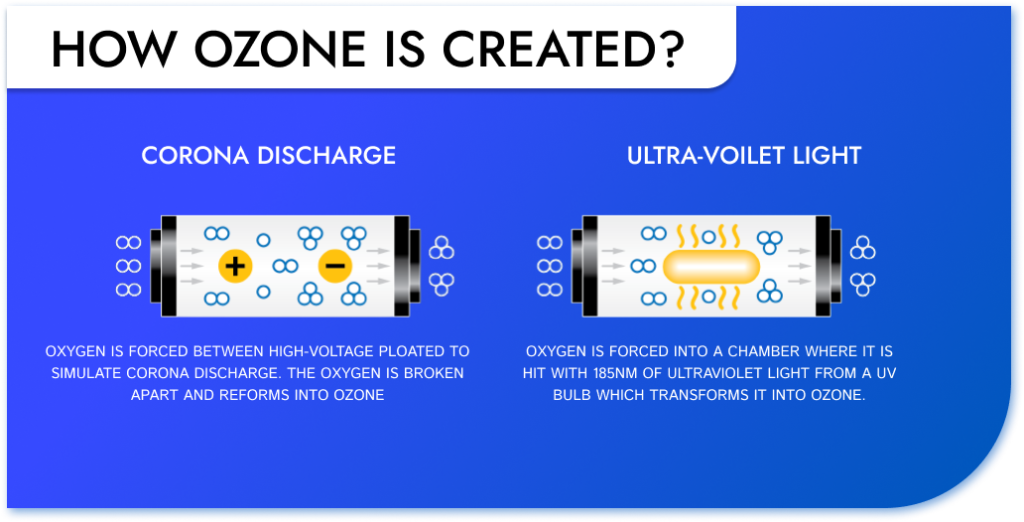Ozone, or O3, has three oxygen particles. It is unsafe and quickly reacts with any gas molecules it comes in touch with. This has a powerful oxidative result that helps clear some smells.
Carbon filters release odors by trapping them as they pass through the air purifier.
In distinction, ozone generators emit ozone into the room. Ozone responds to odours and changes its chemical form.
How ozone is created?

Ozone is created in many methods. The most common way to create ozone is with a Corona Discharge method.
The Corona Discharge method is how most ozone generators work. They use high-powered electrical charges to convert O2 into the dangerous gas of the same name -O3
What is Ozone generator used for?
Ozone generators are a type of technology used in some air purifiers that produce ozone, a highly reactive molecule consisting of three oxygen atoms. Ozone generators are designed to remove pollutants and odors from the air by oxidizing them, which breaks down their chemical structure and neutralizes their effects.
Some air purifier manufacturers have stopped including ozone generators in their products altogether, and many health organizations advise against using air purifiers with ozone generators, especially in residential settings.
Overall, if you are considering an air purifier, it is best to look for models that use other types of technology such as HEPA filters or activated carbon to purify the air rather than relying on ozone generators.
How long does Ozone last in air?
The length of time that ozone lasts in the air depends on a variety of factors, such as temperature, humidity, and the amount of ozone present. In general, ozone has a relatively short half-life, which means that it will break down into oxygen relatively quickly.
At room temperature and normal humidity levels, ozone will typically last for about 30 minutes to 2 hours. However, in more humid conditions or at lower temperatures, ozone can last for longer periods of time.
OZONE GENERATOR DANGERS
In the United States, we are lucky to have access to some of the best medical research in the world. However, it can be hard to know what to believe when it comes to ozone therapy. There is a lot of conflicting information out there, and it can be tough to sort through it all.
After reading through every bit of research we could find, we have not come across any credible source that suggests ozone is good. Rather, it comes with many cautions. While ozone therapy is still relatively new, the evidence we have indicates that it is not safe. We advise against trying it and instead suggest talking to your doctor about other options.
Ozone generators are devices that emit O3, or ozone, a gas that’s made up of three oxygen atoms. O3 is a powerful oxidant that can quickly destroy bacteria, mold, and viruses.
They’re also becoming increasingly popular as air purifiers. While ozone can be an effective way to clean the air, it can also be harmful to human health.
Ozone makes your lungs decrease in function, and have severe asthma symptoms, shortness of breath, and chest pain. It also makes your throat irritated and causes you to cough.
NEGATIVE IONIZERS
A negative ionizer is an appliance that emits a negative charge. The goal is to enhance indoor air quality so that it is easier for a HEPA filter to capture the particles.
However, some ionizers create ozone, which can be harmful to your health. If you are buying a room air purifier and it has a negative ionizer, make sure that it doesn’t produce more than 0.05 ppm of ozone.
OZONE ALTERNATIVES
All air purifiers sold to consumers are certified to operate within secure ozone limits. Because California is such a large and influential state, this has in turn set a national standard. As a result, an ozone generator is nowadays being sold as a commercial product. However, it does not seem to be available to consumers yet.
If you want to release odors safely, using an activated carbon filter is best. it won’t introduce pollution into your home and will give your home clean, fresh air. In this article, we go into some detail about what to look for. Activated carbon is not good for all odors but does a good job with smoke odors and general odors.
Ozone Alternatives
There are several alternatives to ozone generators for improving indoor air quality:
- HEPA filters: High-Efficiency Particulate Air (HEPA) filters are highly effective at removing tiny particles from the air, including dust, pollen, and pet dander. HEPA filters are the gold standard for air purifiers, and many models on the market use this technology.
- Activated carbon filters: Activated carbon filters are highly effective at removing odors and volatile organic compounds (VOCs) from the air. These filters work by adsorbing gases and chemicals onto the surface of the filter, trapping them and preventing them from being released back into the air.
- UV-C light: Ultraviolet-C (UV-C) light can be used to kill bacteria, viruses, and other microorganisms in the air. UV-C light is typically used in combination with other technologies such as HEPA filters to provide comprehensive air purification.
- Ionizers: Ionizers use an electric charge to create negative ions, which attach to particles in the air and cause them to clump together. Once the particles have clumped together, they can be more easily captured by filters or settle out of the air.
